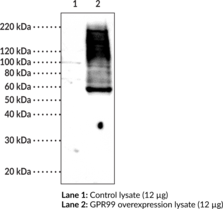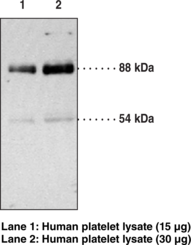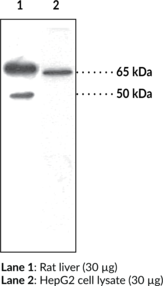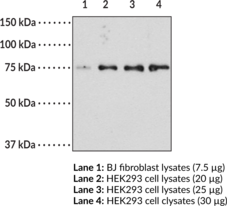Description
GPR99 is a G protein-coupled receptor (GPCR) that was originally identified as a purinergic receptor, P2Y15.{47265,47266} However, it is activated by leukotriene E4 (LTE4; Item No. 20410) in the low nanomolar range and by α-ketoglutarate in the high micromolar range.{23197,19519} It is found in the CNS, kidney, epididymis, and other tissues in the mouse, as well as in human kidney, nasal turbinates, and lung, among other tissues.{47267,47268} GPR99 knockout in mice prevents vascular leakage induced by LTE4 and epithelial cell mucin release in mouse nasal mucosa induced by LTE4 or A. alternata.{23197} In the kidney, under acid-base stress, it is involved with the regulation of carbonic acid and sodium chloride resorption through activation by α-ketoglutarate.{47267} GPR99 is also expressed in mouse retina, and axon growth is increased when it is activated by α-ketoglutarate in isolated mouse embryo retinal explants.{47269} Cayman’s GPR99 (C-Term) Polyclonal Antibody can be used for Western blot and immunohistochemistry (IHC) applications. The antibody recognizes the C-terminus of GPR99 from human samples.
Synonyms: 2-Oxoglutarate Receptor 1|G Protein-Coupled Receptor 80|G Protein-Coupled Receptor 99|GPR80|OXGR1|P2Y Purinoceptor 15|P2Y15|P2Y-like GPCR|P2Y-like Nucleotide Receptor|α-Ketoglutarate Receptor 1
Immunogen: Synthetic peptide from the C-terminal region of human GPR99
Formulation: 500 µl of peptide affinity-purified antibody
Isotype:
Applications: IHC and WB
Origin:
Stability: 365 days
Application|Immunocytochemistry||Application|Immunohistochemistry||Application|Western Blot||Product Type|Antibodies|Polyclonal Antibodies||Research Area|Cardiovascular System|Kidney & Renal Disease||Research Area|Cardiovascular System|Vasculature||Research Area|Lipid Biochemistry|Lipoxygenase Pathways||Research Area|Neuroscience|Ophthalmology




